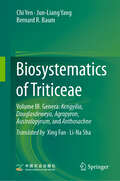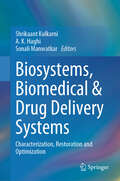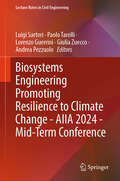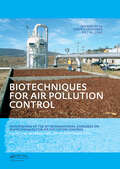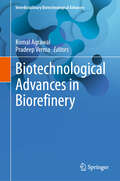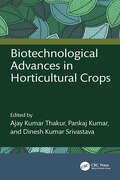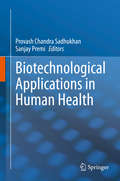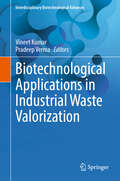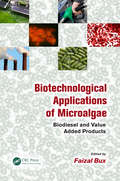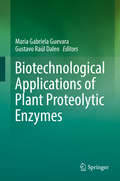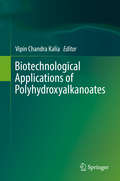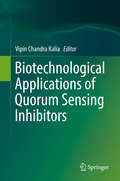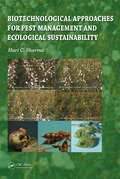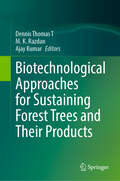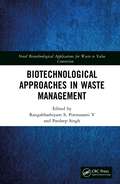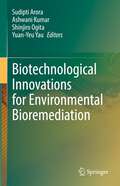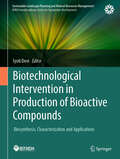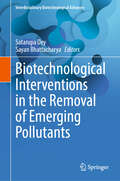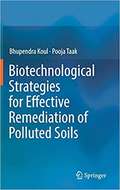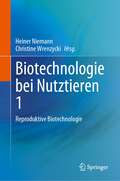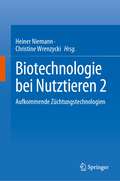- Table View
- List View
Biosystematics of Triticeae: Volume III. Genera: Kengyilia, Douglasdeweya, Agropyron, Australopyrum, and Anthosachne
by Chi Yen Jun-Liang Yang Bernard R. BaumThis book discusses the natural classification and biosystematics of Triticeae and presents the most significant findings of comprehensive studies on the Triticeae, an important tribe in the grass family (Poaceae) that includes major crops such as wheat, barley, rye, and triticale, as well as various forage crops found in different genera. The five-volume Chinese version of Biosystematics of Triticeae was published in 1998, 2004, 2006, 2011, and 2013, and included the 30 genera, two subgenera, 464 species, nine subspecies, and 186 varieties of Triticeae identified to date. This is their English edition. The volumes cover a wide range of disciplines from traditional taxonomy and cytogenetics to molecular phylogeny. They are designed for biologists, plant breeders, taxonomists, geneticists, biogeographic researchers, historians, biotechnologists, agriculturalists, and evolutionists. Volume I, Triticum-Aegilops complex focuses on the taxonomy and generic relationships of Triticum and Aegilops, discussing the origin of common wheat as a crop. Volume II, Genera: Secale, Tritiosecale, Pseudosecale, Eremopyrum, Henrardia, Taeniantherum, Heteranthelium, Crithopsis, and Hordeum highlights a number of genera that are closely related based on their morphological classification and that contain only one unique genome. Volume III describes perennial genera and species including Kengyilia, Douglasdeweya, Agropyron, Australopyrum, and Anthosachne. Volume IV addresses perennial genera and species including Stenostachys, Psathyrostachys, Leymus, Pseudoroegneria, and Roegeneria. Volume V presents perennial genera and species such as Campeiostachys, Elymus, Pascopyrum, Lophopyrum, Trichopyrum, Hordelymus, Festucopsis, Peridictyon, and Psammopyrum.
Biosystems, Biomedical & Drug Delivery Systems: Characterization, Restoration and Optimization
by A. K. Haghi Shrikaant Kulkarni Sonali ManwatkarThe book gives an insight into the thorough study and examination of incumbent biosystems, their present status and disruption in their integrity, causes and effects, measures to be taken for their characterization and restoration apart from advances and applications in the field of biosciences, drug design, discovery, bio-systems, biomedical and drug delivery technologies, tools in particular. The book collates information from several disciplines, such as chemistry, biology, material science, engineering, statistics, biomedicine, genetics, etc., as the subject in question is a confluence of many disciplines exhibiting numerous applications such as bioimaging, novel biological agents, synthesis, discovery testing, characterization of drugs right from selecting a suitable precursor to discovering and designing a drug following a correct synthetic route, adoption of computer simulation-based models, AI/ML-based models, application of statistical tools in analyzing and interpreting data, design, multi-functional, and operational drug delivery systems, their bio-compatibility, capacity of carrying and release of drug reproducibly etc. The book is helpful to postgraduate students, research scholars, academicians, and scientists from the pharmaceutical, biotechnology, and chemical engineering domains. The book covers a conceptual understanding of the exploration of drugs in unity with the applications desired, sound bio-system development, and carriers for drug and supplement delivery.
Biosystems Engineering Promoting Resilience to Climate Change - AIIA 2024 - Mid-Term Conference (Lecture Notes in Civil Engineering #586)
by Luigi Sartori Paolo Tarolli Lorenzo Guerrini Giulia Zuecco Andrea PezzuoloThis book gathers the latest advances and innovations in the field of innovative biosystems engineering for sustainable agriculture, forestry and food production, as presented at the International Mid-Term Conference of the Italian Association of Agricultural Engineering (AIIA), held in Padova, Italy, on June 17-19, 2024. Focusing on the challenges of implementing sustainability in various contexts in the fields of biosystems engineering, it shows how the research has addressed the sustainable use of renewable and non-renewable resources. It also presents possible solutions to help achieve sustainable production. The Mid-Term Conference of the Italian Association of Agricultural Engineering (AIIA) is part of a series of conferences, seminars and meetings that the AIIA organizes, together with other public and private stakeholders, to promote the creation and dissemination of new knowledge in the sector. The contributions included in the book were selected by means of a rigorous peer-review process, and offer an extensive and multidisciplinary overview of interesting solutions in the field of innovative biosystems engineering for sustainable agriculture.
Biotechniques for Air Pollution Control: Proceedings of the 3rd International Congress on Biotechniques for Air Pollution Control. Delft, The Netherlands, September 28-30, 2009
by Jan Bartacek Christian Kennes Piet N.L. LensEnergy and feedstock materials for the chemical industry show an increasing demand. With constraints related to availability and use of oil, the energy and chemical industry is subject to considerable changes. The need for the use of cheaper and widely available feedstocks, and the development of sustainable and environmentally friendly c
Biotechnological Advances in Biorefinery (Interdisciplinary Biotechnological Advances)
by Komal Agrawal Pradeep VermaThis book is unique as it will cover the latest technological advancements in the field of biorefinery and how it is a major futuristic component of global biofuel research. Initially, the role of bio-based waste materials, microorganisms, and their bioactive metabolites in biorefinery will be focused. Further, recent advances and emerging topics that are related to industrially important products such as biofuels, hydrogen production will also be elaborated. The book addresses the lack of understanding of recent technological advancement such as life cycle assessment (LCA) and techno-economic assessment (TEA) as well. The systems for biorefineries demand a methodical approach to identifying effects and evaluating their long-term viability. Thus, a futuristic paradigm focusing on in silico studies, will also be incorporated, enabling us to understand the developments and impacts of bio-based materials towards a circular and sustainable economy. Additionally the proposed book will also discuss various strategies such as the analysis of cost-effectiveness, nanotechnology, value sensitive design (VSD) and also emphasize the economic, technical, and environmental aspects that affect their production as well as the future perspective in terms of the market scenario. Thus, the book will provide cumulative information on various dimensions of biorefinery and its role as a major bio-economic industry of the future for researchers, industrialists, entrepreneurs, career starters, and policymakers. The shift towards a bioeconomy not only promises innovative solutions to pressing global challenges but also opens up new avenues for various industries and policymakers. Thus, biorefinery is regarded as a crucial aspect of biobased economy ultimately leading the path towards sustainability.
Biotechnological Advances in Horticultural Crops
by Ajay Kumar Thakur Pankaj Kumar Dinesh Kumar SrivastavaThe field of horticultural biotechnology has witnessed remarkable growth in recent years, offering profound insights and innovations that are reshaping agriculture's future. Biotechnological Advances in Horticultural Crops serves as a comprehensive guide to the latest innovations and applications. This meticulously curated volume bridges the gap between fundamental knowledge and cutting-edge advancements. From plant tissue culture to genomic approaches, this book spans a diverse array of topics, catering to a broad audience of students, researchers, and academics.Key Features: In-depth exploration of plant tissue culture and its applications in horticultural crop improvement. Insightful coverage of transgenic approaches in fruit crops, including genetic modifications for enhancing fruit quality, yield, and resistance to pests and diseases. Detailed examination of the application of omics sciences in tropical fruits, opening up new perspectives for crop improvement and sustainable production. Extensive discussion on the potential of in vitro production techniques for underutilized and unconventional horticultural crops. Exploration of sustainable agriculture practices, including the use of beneficial microbes and the scientific validation of natural and organic farming practices. This book is more than just a collection of topics; it’s a gateway to the transformative potential of biotechnology in horticulture. It empowers readers (students, researchers, and academicians) to comprehend and harness these advancements, promoting innovation and sustainability in horticultural crop improvement.
Biotechnological Applications in Human Health
by Provash Chandra Sadhukhan Sanjay PremiThis book compiles selected articles presented at the International Conference on Biotechnology & Biological Sciences, BIOSPECTRUM 2017, organized by the Department of Biotechnology, University of Engineering & Management, Kolkata. Focusing on biotechnology-based analysis and intervention to address certain human diseases, the book includes a holistic discourse on disease profiling, molecular level analysis of diseases, and non-invasive medical interventions. It features articles on non-invasive treatment of iron deficiency anemia with iron nanoparticles; novel diagnosis methods based on microarray data; analysis using machine learning techniques like artificial neural network for early detection and treatment of cancer; and drug discovery for preventing the growth of human leukemic cells. Further, the book sheds light on in silico drug design using lipopeptides, and identifying the binding sites for their corresponding ligands. Presenting the concepts of the design of potent and safe antimicrobial compounds to fight multi drug resistant pathogens, it also includes interesting reviews on the design and development of various non-invasive methods, such as multi NIR wavelength probes to identify the risk areas in the diabetic foot at an early stage; and a low-cost cochlear implant prototype designed and developed from commercial off the-shelf components to empower the hearing impaired.The book appeals to students, academics and researchers in a wide range of subject areas, including biotechnology, life sciences, medicine and cancer research.
Biotechnological Applications in Industrial Waste Valorization (Interdisciplinary Biotechnological Advances)
by Vineet Kumar Pradeep VermaThis book overviews the cutting-edge applications of biotechnological tools and techniques in valorizing industrial waste to achieve the United Nations Sustainable Development Goals. It provides comprehensive insights into the latest research, technologies, processes, and case studies, making it an invaluable resource for researchers, professionals, policymakers, and students interested in waste management, bioenergy recovery, and sustainable development. By transforming industrial waste into high-value products, this book fosters a circular economy and lessens environmental strain, bridging the gap between academia and industry with practical solutions and innovative strategies. It seeks to fill the gap between academics and industry by outlining workable solutions and discussing cutting-edge tactics that can be used in realistic situations. While providing an in-depth exploration of advanced biotechnological techniques being widely used to valorize industrial waste, the book covers a wide range of issues that help academics and professionals efficiently deal with various waste streams, such as microbial bioremediation, renewable energy, resource recovery, enzymatic degradation, metabolic engineering, bioprocess development, and others. The book intends to motivate and guide students, researchers, practitioners, and policymakers in pursuing sustainable waste management strategies by exhibiting the revolutionary power of microbial technology. The concise and impartial content structure will also benefit corporate researchers. It is an essential resource for anyone interested in the intersection of biotechnology and environmental sustainability, offering insights that are both academically rigorous and practically applicable.
Biotechnological Applications of Microalgae: Biodiesel and Value-Added Products
by Faizal BuxMicroalgae are an invaluable biomass source with potential uses that could lead to environmental and economic benefits for society. Biotechnological Applications of Microalgae: Biodiesel and Value Added Products presents the latest developments and recent research trends with a focus on potential biotechnologically related uses of microalgae. It gi
Biotechnological Applications of Plant Proteolytic Enzymes
by María Gabriela Guevara Gustavo Raúl DaleoThis book offers an overview of the diverse fields application of proteases (also termed proteolytic enzymes or proteinases), including food science and technology, pharmaceutical industries, and detergent manufacturing, reviewing the advances in the biotechnological application plant proteolytic enzymes over the last decade. In recent years, they have been the focus of renewed attention from the pharmaceutical and biotechnology industries, not only because of their activity on a wide variety of proteins but also because they are active over a range of temperatures and pHs. The main audience of this book are researchers working with plant proteases but also professionals from several industry segments such as food production and pharmaceutical companies.
Biotechnological Applications of Polyhydroxyalkanoates
by Vipin Chandra KaliaThis book presents the latest research on the uses of polyhydroxyalkanoates (PHA), introducing readers to these natural, biodegradable polyesters produced by microorganisms, their functions and applications. The individual chapters discuss the various potentials of these bioplastics, which offer an attractive alternative to non-biodegradable plastics. The book also describes the diverse medical and biomedical applications of PHAs, including their use as drug carriers, memory enhancers, and biocontrol agents, and examines their role in creating a more sustainable economy – which is the need of the hour.
Biotechnological Applications of Quorum Sensing Inhibitors
by Vipin Chandra KaliaThis book discusses the practical applications of quorum sensing inhibitors for both human and plant health. Quorum sensing inhibitors that disrupt microbial biofilms can be employed to treat bacterial infections. The book describes the various bioactive molecules that can serve as quorum sensing inhibitors to combat deadly bacterial infections, in addition to several synthetic quorum sensing inhibitors. Quorum sensing is the mechanism through which bacteria develop antibiotic resistance. Intended to provide a clearer understanding of the practical applications of quorum sensing inhibitors, the book details how the problem of antibiotic resistance can be countered through the intelligent application of quorum sensing inhibitors.
Biotechnological Approaches for Pest Management and Ecological Sustainability
by Hari C SharmaDue to increasing problems occurring from massive applications of pesticides, such as insect resistance to pesticides, the use of biotechnological tools to minimize losses from insect pests has become inevitable. Presenting alternative strategies for alleviating biotic stresses, Biotechnological Approaches for Pest Management and Ecological Sustain
Biotechnological Approaches for Sustaining Forest Trees and Their Products
by Ajay Kumar M. K. Razdan Dennis Thomas TThis edited book gives an in-depth coverage of various aspects of biotechnological procedures followed by international scientists and researchers to sustain growth and improvement of forests in context of current climatic change. Forests especially trees play a crucial role in maintaining the ecological balance as well as in the functioning of natural ecosystem. More importantly, they contribute to the economic growth of a country through its products such as timber, fuel, pharmaceuticals, fibre for textile industry and edible fruits. The denudation of trees due to urbanisation of towns/cities/villages by various construction activities and industrialisation directly impact the climate change resulting in global warming, short rainfall or erroneous weather currently experienced. This book is an effort to address these problems and attempts to find out solutions using biotechnological approaches. Most of the proposed chapters cover latest information. The proposed book deals with biotechnological aspects of forest trees such as micropropagation, somatic embryogenesis, somaclonal variation, synthetic seeds, cryopreservation, disease amangement and genetic engineering. Further, applications and limitations of these approaches to improve the forest trees are discussed. The book is of relevance to teachers, students and researchers working in area of forest and plant biotechnology globally.
Biotechnological Approaches in Food Adulterants
by Madan L VermaThe book highlights the biotechnological advancement in the area of food adulterants and outlines the current state of art technologies in the detection of food adulterants using omics and nanobiotechnology. The book provides insights to the most recent innovations, trends, concerns, and challenges in food adulterants. It identifies key research topics and practical applications of modern cutting-edge technologies employed for detection of food adulterants including: expansion of food adulterants market, potential toxicity of food adulterants and the prevention of food adulteration act, cutting-edge technology for food adulterants detection, and biosensing and nanobiosensing based detection of food adulterants. There is need for new resources in omics technologies for the application of new nanobiotechnology. Biotechnological Approaches in Food Adulterants provides an overview of the contributions of food safety and the most up-to-date advances in omics and nanobiotechnology approaches to a diverse audience from postgraduate students to researchers in biochemical engineering, biotechnology, food technologist, environmental technologists, and pharmaceutical professionals.
Biotechnological Approaches in Waste Management (Novel Biotechnological Applications for Waste to Value Conversion)
by Rangabhashiyam SWaste generation from industrial and domestic sectors are imposing a very challenging environment and intervention of biotechnology offers a viable solution for their effective management. This book deals with the employment of biotechnological aspects for waste treatment including the basic concepts, biochemical processes and various technologies for pollutant reduction and production of value-added products for a cleaner environment. It covers different aspects of biotechnology in the conservation of environment dealing with the sustainable management of waste through the concept of waste-to-economy along with the management of environmental pollutants and natural resource conservation. Focusses on ecological approaches i.e., the use of biocatalysts and biotechnological approaches for waste management Explores the different biotechnology-based solution for the removal of environmental pollutants Covers various microbiological routes, technological options for waste to energy, removal of contaminants and the production of value-added products Reviews the bioremediation potential of microbial strains and enzymes Explores the significant routes of biotechnological means of obtaining eco-friendly products substituting the hazardous chemical-based products This volume is aimed at researchers and professionals in environmental, biotechnology and chemical engineering.
Biotechnological Approaches to Enhance Plant Secondary Metabolites: Recent Trends and Future Prospects
by Mohd. ShahnawazThousands of secondary metabolites are produced by plants to withstand unfavourable environmental conditions and are important molecules for nutraceutical, agro, cosmetic and pharmaceutical industries, etc. Harvesting of plants for the extraction of these important metabolites can threaten the plant germplasm, and various medicinally important plants are at the verge of extinction. Based on need, various methods and strategies were developed and followed by researchers from time to time to save the plant germplasm and produce important secondary metabolites efficiently to meet their growing demands. Biotechnological Approaches to Enhance Plant Secondary Metabolites: Recent Trends and Future Prospects provides a comprehensive introduction and review of state-of-the-art biotechnological tools in this field of research at global level. The methodologies are highlighted by real data examples in both in vitro and in vivo level studies. The book: • Highlights and provides overviews of the synthesis, classification, biological function and medicinal applications of the recent advancements for the enhanced production of novel secondary metabolites in plants • Provides an overview of the role of induced mutation, salinity stress and brassinosteroids impact to increase the secondary metabolic contents in plants and suggests an increase in enzymatic activity in plants could be due to various point mutations, which in turn could play a role at transcriptome levels • Discusses the significant role of endophytes to enhance the contents of plant secondary metabolites • Alternatively, suggests the urgent need to set up the standard operating procedures using hydroponics system of cultivation for significant enhancement of secondary metabolite contents • Enlists various in vitro techniques to enhance plant secondary metabolites contents using plant tissue culture approaches • Provides a systematic overview of state-of-the-art biotechnological tools CRISPER Cas9 and RNAi to enhance the plant secondary metabolite contents • Recommends CRISPER Cas9 technology over RNAi, ZFNs and TALENs because of its relatively simple and high precision method with an easily programmable tool This serves as a reference book for the researchers working in the field of plant secondary metabolites and pharmaceutical industries at global level.
Biotechnological Approaches to Sustainable Development Goals
by Patrick Omoregie Isibor Paul Akinduti Solomon U. Oranusi Jacob O. PopoolaBiotechnological Approaches to Sustainable Development Goals presents selected contributions from the 2022 International Biotechnology Conference Exhibition and Workshop (IBCEW) that cover techniques, current trends, and cutting-edge biotechnological tools for achieving sustainable development goals (SDGs). The authors explore recent advances that solve challenges related to sustainable agriculture, climate change, prevention and control of pandemics, biotechnology for a sustainable economy, and biotechnological industries and SDGs. The IBCEW aims to share knowledge, experiences, and ideas among scientists, academics, students, industry representatives, and other professionals interested in biotechnology and attaining SDGs for development in Nigeria, Africa, and globally.
Biotechnological Innovations for Environmental Bioremediation
by Sudipti Arora Ashwani Kumar Shinjiro Ogita Yuan-Yeu YauThis edited book focuses on the application and implementation of bioremediation and other strategies to create a sustainable and healthy environment. It provides a collection of approaches to environmental biotechnology for wastewater treatment, removal of soil heavy metals, degradation of pesticides, removal of dyes, waste management, and microbial conversion of environmental pollutants. This book brings to the fore contributions of certain globally important environmental biotechnologist. Bioremediation is a popular branch of biotechnology that involves the use of living organisms such as microorganisms (microbial remediation), bacteria, fungus (mycoremediation), and plants (phytoremediation) to bind, extract, and clean up contaminants, pollutants, and toxins from soil, groundwater, and other environments. This book is of interest to researchers, scientists, and academic faculty in environmental sciences. Also, it serves as additional reading and reference material for undergraduate and graduate students as well as postdocs in environmental, agriculture, ecology, and soil sciences. National and International policy makers will also find valuable information from this book.
Biotechnological Intervention in Production of Bioactive Compounds: Biosynthesis, Characterization and Applications (Sustainable Landscape Planning and Natural Resources Management)
by Jyoti DeviThis book provides an overview of the state of our understanding regarding the biosynthesis of bioactive compounds from plant and microbial sources. Additionally, examples of how these compounds have been used in food, agriculture, and human health are provided, as well as the biotechnological approach for screening and characterizing bioactive compounds. In the pharmaceuticals, nutraceuticals, and agrochemicals industries, bioactive molecules are crucial to the production of high-value products. The discovery of bioactive chemicals from diverse sources has supported their use as medications, functional food ingredients, herbicides, and insecticides due to their medicinal advantages, nutritional importance, and protective impacts in healthcare and agriculture. The systematic investigation of biologically active products and the prospective biological activities of these bioactive compounds, comprising their medical uses, standardization, quality control, mode of action, and possible biomolecular interactions, are among the greatest sensational expansions in modern natural medication and healthcare. This book is a useful resource for graduate and undergraduate biomedical chemistry and agriculture students who are interested in learning more about the possibilities of bioactive natural products. This book is useful to researchers in a variety of scientific domains where natural products are important.
Biotechnological Interventions in the Removal of Emerging Pollutants (Interdisciplinary Biotechnological Advances)
by Satarupa Dey Sayan BhattacharyaThis book focuses on the most recent developments in bioremediation techniques, exploring how microorganisms can break down different pollutants and the future potential of bioremediation to reduce global pollution levels. It examines the impact of various emerging pollutants on the environment and the health of living organisms while highlighting recent advancements in bioremediation methods needed to degrade these pollutants. Addressing both inorganic and organic compounds from industrial and anthropogenic activities, including personal care products, endocrine disruptors, and pharmaceutical products, this book tackles pollutants that escape conventional water treatment processes, contaminating groundwater, soil, sediments, and oceans. The chapters also cover topics such as the toxicity and health impacts of emerging pollutants, ecotoxicological effects of nanoparticles, policies related to emerging pollutants, technologies for their detection, and technological aspects of their fate during wastewater treatment. Readers will find a comprehensive examination of the roles of microbes in bioremediation, including the elimination, degradation, detoxification, and immobilization of pollutants. The book also introduces enzyme biotechnology as a cost-effective, low-energy, eco-friendly technology for treating various pollutants. Furthermore, it discusses the combination of physical treatment and nanotechnology for sustainable pollutant removal. This book serves as a valuable resource for policymakers aiming to develop effective environmental regulations, educators seeking comprehensive educational material, researchers looking to expand their knowledge on advanced bioremediation techniques, climate change scientists dedicated to mitigating pollution, and undergraduate and graduate students studying agriculture, forestry, ecology, soil science, or environmental sciences.
Biotechnological Strategies for Effective Remediation of Polluted Soils
by Bhupendra Koul Pooja Taak<p>This book presents a comprehensive collection of various in situ and ex-situ soil remediation regimes that employ natural or genetically modified microbes, plants, and animals for the biodegradation of toxic compounds or hazardous waste into simpler non-toxic products. These techniques are demonstrated to be functionally effective in connection with physical, chemical, and biological strategies. <p>Soil and water contamination through heavy metals, hydrocarbons and radioactive wastes is of global concern, as these factors have cumulative effects on the environment and human health through food-chain contamination. The book discusses the utilization of algae, plants, plant-associated bacteria, fungi (endophytic or rhizospheric) and certain lower animals for the sustainable bioremediation of organic and inorganic pollutants. In addition, it explores a number of more recent techniques like biochar and biofilms for carbon sequestration, soil conditioning and remediation, and water remediation. It highlights a number of recent advances in nanobioremediation, an emerging technology based on biosynthetic nanoparticles. Lastly, it presents illustrative case studies and highlights the successful treatment of polluted soils by means of these strategies.</p>
Biotechnologie bei Nutztieren 1: Reproduktive Biotechnologie
by Heiner Niemann Christine WrenzyckiDieses zweibändige Lehrbuch bietet einen umfassenden Überblick über das weite Feld der Tierbiotechnologie mit besonderem Schwerpunkt auf der Reproduktion und Zucht von Nutztieren. Der Leser wird mit einer Vielzahl modernster Technologien und neuer genetischer Instrumente und deren Anwendungen in der Tierproduktion vertraut gemacht. Außerdem werden ethische und rechtliche Aspekte der Tierbiotechnologie erörtert und neue Trends und Entwicklungen auf diesem Gebiet kritisch bewertet. Das zweibändige Werk ist ein Muss für Doktoranden, fortgeschrittene Studenten und Forscher auf dem Gebiet der Veterinärmedizin, Genetik und Tierbiotechnologie.Dieser erste Band befasst sich hauptsächlich mit künstlicher Befruchtung, Embryotransfertechnologien bei verschiedenen Tierarten und der Kryokonservierung von Eizellen und Embryonen.
Biotechnologie bei Nutztieren 2: Aufkommende Züchtungstechnologien
by Heiner Niemann Christine WrenzyckiDieses zweibändige Lehrbuch bietet einen umfassenden Überblick über das weite Feld der Tierbiotechnologie mit besonderem Schwerpunkt auf der Reproduktion und Zucht von Nutztieren. Der Leser wird mit einer Vielzahl modernster Technologien und neuer genetischer Instrumente und deren Anwendungen in der Tierproduktion vertraut gemacht. Außerdem werden ethische und rechtliche Aspekte der Tierbiotechnologie erörtert und neue Trends und Entwicklungen auf diesem Gebiet kritisch bewertet. Das zweibändige Werk ist ein Muss für Doktoranden, fortgeschrittene Studenten und Forscher auf dem Gebiet der Veterinärmedizin, Genetik und Tierbiotechnologie.Dieser zweite Band ist den genetischen Werkzeugen der Tierbiotechnologie gewidmet, wie dem somatischen Klonen, transgenen Technologien und der Anwendung von Stammzellen in der Tierzucht. Auch ethische und rechtliche Aspekte werden erörtert.
Biotechnologies and Biomimetics for Civil Engineering
by Fernando Pacheco Torgal J. A. Labrincha M. V. Diamanti C. P. Yu H. K. LeePutting forward an innovative approach to solving current technological problems faced by human society, this book encompasses a holistic way of perceiving the potential of natural systems. Nature has developed several materials and processes which both maintain an optimal performance and are also totally biodegradable, properties which can be used in civil engineering. Delivering the latest research findings to building industry professionals and other practitioners, as well as containing information useful to the public, 'Biotechnologies and Biomimetics for Civil Engineering' serves as an important tool to tackle the challenges of a more sustainable construction industry and the future of buildings.
